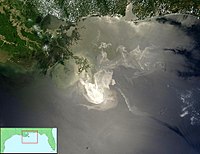
Photo from wikipedia
Abstract Twenty-five 106 yr-scale and fifteen 105 yr-scale greenhouse aggradational to progradational clinothem pairs with rising-then-flat rollover trajectories were recognized in the Oligocene Qikou and Eocene Dongying sags in the… Click to show full abstract
Abstract Twenty-five 106 yr-scale and fifteen 105 yr-scale greenhouse aggradational to progradational clinothem pairs with rising-then-flat rollover trajectories were recognized in the Oligocene Qikou and Eocene Dongying sags in the Bohai Bay Basin. A comparison of them highlights the pivotal but underappreciated role of time scales on shelf-edge- or clinothem-based prediction of sediment dispersal to deepwater (i.e., different time scales involve different drivers of sediment dispersal to deepwater), drawing the attention of the pitfall of mechanically applying sequence stratigraphy to lacustrine basins. Over time scale of 106 yr, flat topset-to-foreset rollover trajectories and aggradational-progradational-degradational (APD) clinothem sets are all the predictors of the delivery of coarse-grained terrestrial sediments into deep-lake floors of the Eocene Qikou sag, as evidenced by the occurrence of aggradational bottomsets in front of them. Over time scale of 105 yr, rising topset-to-foreset rollover trajectories and aggradational-progradational (PA) clinothem sets are, in contrast, the proxy for sediment dispersal to lake-floor areas of the Eocene Dongying sag, as evidenced by the occurrence of aggradational clinoforms in front of them. On a longer time scale of 106 yr or more, tectonics and climates are greatly varied. Sediment dispersal to deepwater is then facilitated by the base-level falls, and is predicted by flat shelf-edge or rollover trajectories and PA clinothem sets. On a shorter time scale of 105 yr or less, only climates are highly variable. Sediment dispersal to deepwater is then facilitated by the lake-level rises (i.e., more humid climates), and is predicted by rising shelf-edge or rollover trajectories and APD clinothem sets.
Journal Title: Marine and Petroleum Geology
Year Published: 2021
Link to full text (if available)
Share on Social Media: Sign Up to like & get
recommendations!